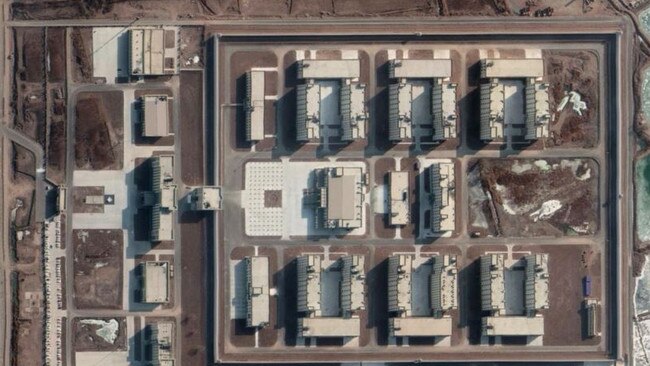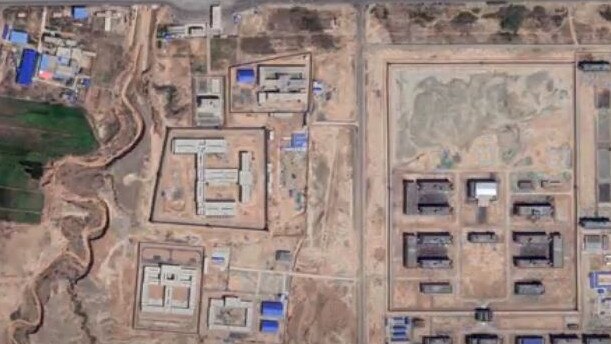Australian researchers map hundreds of Uighur detention centres
Australian researchers identify 380 suspected detention centres in Xinjiang, despite Chinese claims that detainees had ‘graduated’.

Australian researchers have identified and mapped more than 380 suspected detention centres in China’s far-western Xinjiang region, including “re-education camps” and high-security prison-style facilities.
Despite Chinese claims that detainees held in the centres had all “graduated” by the end of 2019, satellite imagery shows the expansion of at least 61 detention facilities between July 2019 and July 2020, and 14 new facilities still under construction.
The database of Xinjiang detention facilities, compiled by the Australian Strategic Policy Institute, is the world’s most extensive, and reveals about half of the centres are high-security facilities.
-
VIDEO: Timelapse videos showing the construction of high security Uigher camps, and 3D images of the camps
-
Lead researcher Nathan Ruser said this suggested a shift away from lower-security “re-education camps” towards more prison-style facilities.
“For example, a new 60-acre detention camp in Kashgar with 13 five-storey residential buildings surrounded by a 14-metre high wall and watch towers, was completed and opened as recently as January 2020,” Mr Ruser said.
“In 2019 alone, new buildings added to Xinjiang’s largest camp, in Dabancheng near Urumqi, stretched over one kilometre in length, with this new construction finishing in November 2019.”
The research team also found about 70 camps had been “de-securitised” through the removal of barbed wire and internal fencing, including eight camps that appeared to have been decommissioned.

Australia recently joined 26 nations to condemn China’s human rights violations against Uighurs and other minorities in Xinjiang, where the United Nations and human rights activists say between one and two million detainees are subject to political indoctrination and forced labour.
But China recently released a new white paper defending its “vocational training centres” in Xinjiang, claiming nearly 1.3 million workers a year had gained skills under the system between 2014 and 2019.
The ASPI researchers located the camps using satellite imagery, construction tender records, and first hand reports by activists and journalists.
“One of the most effective methods was the examination of night-time satellite imagery from Xinjiang,” Mr Ruser said.
“Because the vast majority of the camps that we located were built on previously unused land, it was possible to compare illuminated areas in the first few months of 2017 – before most of those camps had been constructed – with presently illuminated areas.
“We discovered that the vast majority of newly illuminated areas in Xinjiang were either newly constructed detention facilities or significant new highway checkpoints used to monitor the movement of people across Xinjiang.”
The team found camps were often co-located with factory complexes, highlighting “the direct pipeline between arbitrary detention in Xinjiang and forced labour”.
The researchers used the satellite images to build timelapse videos showing the construction of individual camps, and 3D images of a number of detention centres, which have been uploaded to a new interactive website called the Xinjiang Data Project.
The team classified the facilities into four tiers, based on the level of security imposed on inmates.
The highest-security, tier four facilities “appear to represent the formal detention system in Xinjiang, in which detainees are transferred following a formal sentencing process in the judicial system”.
“Most of the new facilities are considerably larger than pre-2017 prisons in Xinjiang, often with dozens of cell blocks,” Mr Ruser said.
“They are far removed from urban areas, constructed on previously empty land at some distance from any major settlement.”
The tier three facilities are enclosed by high concrete walls, watchtowers and barbed wire fencing.
They “appear to be intended to remove people from society with little intention for serious rehabilitation”, the researchers said.
The tier two “re-education camps” also have large exterior walls and watch towers, but appear to have been “slightly de-securitised” with the removal of some internal walls and barbed wire.
The lowest security, tier one camps are “pre-existing buildings that have been transformed into detention facilities”, the researchers said.
Amid rising tensions between Australia and China, Foreign Affairs Minister Marise Payne said recently that Australia had “longstanding and serious concerns about human rights issues against Uighurs and other minorities in China, particularly in Xinjiang”.
“We have continued to receive evidence of arbitrary detention; on surveillance of individuals; of attacks on their reproductive rights; forced labour – and they are very concerning,” she said after AUSMIN talks in the United States in July.




To join the conversation, please log in. Don't have an account? Register
Join the conversation, you are commenting as Logout